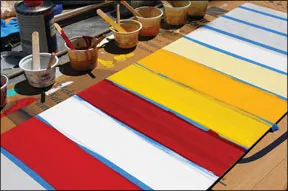
288
All that glitters isn’t gold, and as the price of professional topside makeovers continues to climb, many do-it-yourselfers are looking to other alternatives.
A gleaming paint job remains an icon of yacht-quality maintenance, and paint makers spin the transformative ability of what comes in their cans. The good news is that there’s still some truth in advertising. After a close look at the latest paint systems, Practical Sailor testers offer a report on just how user-friendly topside paints have become.
A few decades ago, an aircraft paint company executive decided to paint his boat with the same stuff used to coat aircraft that flew at 450 knots—the stuff that seemed immune to UV degradation and shed hydraulic fluid like water off a duck’s back. The results were more than impressive, and his experiment with a paint called Alumagrip led to a marine-coatings revolution and the birth of Awlgrip.
With the new brand came a new coating process that featured an epoxy primer and a sprayed linear-polyurethane topcoat. Today, Awlgrip has expanded its line to both polyester and acrylic-modified polyurethane top coats. The paint has become the gold standard among pros, but it’s occasionally used by amateurs.
Paint companies have responded to the demand for do-it-yourself (DIY) glossy finishes, and a plethora of single-part modified alkyd enamels, mono-urethanes, and two-part products line chandlery shelves.
In the same vein as our bottom paint and wood coatings tests, this topside paint evaluation begins with a report on application, handling, coverage, and initial gloss. After some field testing, we’ll rate each paint’s hardness, gloss retention, and long-term durability. Our last long-term look at these products was launched in the Feb. 15, 2002 issue and closed with a final report in the May 2006 issue.
What We Tested
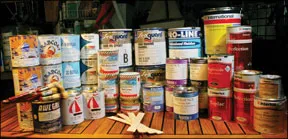
288
We applied 29 topside paints from nine manufacturers to fiberglass panels. With such a large test field, we opted to divide the products by paint type. Of the test paints, seven are alkyd enamels; 12 are one-part urethanes; and eight are two-part linear polyurethane. We’ve classified two as “other” as they fit into none of the categories.
• Enamels: We found that choosing the right topside paint for the job at hand is based both on paint characteristics and applicator skill. At the easiest-to-apply end of the spectrum are traditional alkyd enamels, paints that are relatively soft, easy to sand, and almost creamy in brushability.
In the days of carvel-planked and clinker-built wooden boats, an annual coat of topside paint was part of the spring commissioning routine. The softer enamels delivered a season of shine, oxidizing a little over winter, and by spring, they were ready for a light-scuff sanding and a rejuvenating coat of alkyd enamel. Products like Pettit’s Z-Spar 100 and semi-gloss 101 and Interlux Premium Yacht Enamel were hard to keep on the shelf.
Today, there’s still an “enamel” demand, and products like Sherwin-Williams 1000, Kirby’s Hull and Deck enamel, and Z-Spar 1195 have been added to the fray. These paints excel in their ability to be easily applied. They are reduced with mineral spirit-based solvents and are soft enough for easy sanding between coats. However, the long-term gloss retention and adhesion of enamel is not as good as that of the higher-tech paints that have cornered the market.
• One-parts: In the middle range of topside paint technology are one-part urethane modified enamels. These are harder, glossier, and tougher coatings than alkyd enamels. They exhibit traits more akin to two-part systems, yet handle with almost as much ease as a traditional enamel. They are faster-drying, quicker-to-skin paints, and must be carefully thinned with specific reducers to retain good flow characteristics. A major benefit of these paints is their forgiveness on vertical surfaces where “hangs and sags” are just waiting to happen. Single-part urethane enamels offer multi-year shine, and on a couple of applications we have been field testing, the paint has weathered four years as a nonskid surface in a cockpit sole (Interlux Brightside).
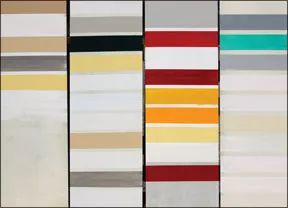
288
• Two-parts: At the high end of the topside paint spectrum—in cost, durability, and gloss—are the two-part linear polyurethane (LPU) products that use an isocyanate catalyst to cure the paint. More a plastic resin than an old-fashion enamel, these “wonder coatings” typically afford a wet look that packs automotive showroom brilliance. The downside of this reflective quality is the need for smooth, even, dust-free application, and the extra effort associated with surface preparation.
All of the two-part products we tested produced superior results but also proved to be more difficult to handle than one-part products. One factor common to all of the two-part paints is the detailed prep work required, but testers found that it does pay off in the long run.
What We Found
• Enamels: Don’t sideline traditional alkyd enamels. They are easy to handle, require less exacting preparation, and are a pure pleasure to brush on. When used in low-abrasion situations where modest gloss is an asset, they can prove to be just the right paint.
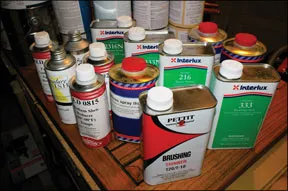
288
Pettit’s Z-Spar No. 1195 Grand Banks Beige stole the show with its smooth, even flow and Excellent coverage. Other oil-based alkyds in the Z-Spar line (Nos. 99 and 100) featured the same remarkable handling quality that makes it a favorite among carvel and clinker-built wooden boat owners.
Both Kirby’s Hull and Deck Enamel gloss white and semi-gloss proved easy to handle and developed a smooth, even skin. The only disappointment was the streaky nature of its medium-gray enamel. Even after re-stirring, it required three coats to develop a smooth hue. The difference highlights the fact that even though one manufacturer makes multiple colors of paint, one color may not have the same gloss or application qualities as another color.
Sherwin-Williams’ Seaguard 1000 was another smooth-flowing, user-friendly, oil-based alkyd enamel. It spread evenly on vertical surfaces and was reluctant to hang or sag.
Bottom Line: Most of the enamels we tested performed well, comparatively. Our top picks so far for application and initial gloss are the Z-Spar Solid Coat No. 99 and Marine Enamel No. 1195.
• Single-part urethane enamels: By far, DIY topside paint technology has grown the most in the one-part urethane modified enamels sector, a best-of-both-worlds formulation that boasts of shine and longevity. Almost as user-friendly as an alkyd enamel and with almost as much gloss as the two-part paints, these hybrids certainly live up to expectations.
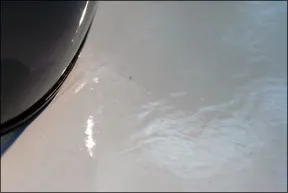
288
In a near photo finish in our application testing, Interlux’s Toplac and Epifanes’ Mono-urethane crossed the line in a dead heat with Insignia’s Resilience rounding out the winners’ circle. (Resilience is branded as a “for pro application-only paint.”) Snapping at their heels were Interlux Brightside, Pettit Easypoxy, and West Marine’s SeaGloss Pro. Two of the most popular colors on the nautical pallet have been Interlux’s Kingston Gray and Hatteras Off White.
Bottom Line: This was a close race, but the very slight edge for application goes to Interlux’s Toplac.
• Two-part paints: When it comes to surface toughness, bright gloss, and maximum longevity, two-part paints stand alone. Paint in name only, these acrylic and polyester modified-urethane resins have the ability to suspend pigment in a flat, highly reflective skin. The trick lies in applying the coating evenly and just thick enough for it to flow, making brush strokes or orange peel disappear.
As with all forms of juggling, a minor slip can spell major problems. Consequently for DIY interest, we looked carefully for paints that behaved well when rolled and brushed. Once again, Interlux and Epifanes crossed the line in a dead heat: Interlux’s Perfection and Epifanes’ Polyurethane products flowed smoothly over horizontal and vertical surfaces and resisted the tendency to hang or sag.
Fabula Inc.’s Signature Finish, which comes with brushes, rollers, tape, mixing graduates, stirrers, and detailed instructions also hit the mark. Sherwin-Williams’s vivid red two-part was the smoothest flowing red of the three we tested. Insignia’s Brilliance, like Awlgrip is a “pro only” recommended product, and once the right amount of brushing reducer was added to cope with the warm weather, these products also ranked as standouts.
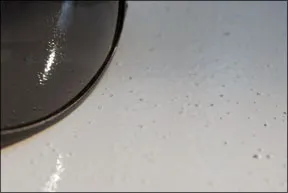
288
The volatility of the solvents in all these two-part system leaves the user with less time to muck around, and maintaining a wet edge is essential to the “cutting in” process. Each manufacturer provides a “slow” brushing reducer that has to be carefully used. Too much causes excess flow—and the drama mentioned earlier of hangs and sags. In short, two-part paints typically provide the best gloss and toughest, longest-lasting finish, but they are the hardest to handle.
Bottom Line: The Awlgrip, Epifanes, and Interlux two-parts were the only products to earn across-the-board Excellent ratings.
• Other: As soon as we popped the lid on the first can of CrystaLac Crab Coat, we noticed change in the air. Absent was the aroma of oil or the volatile solvent jolt of urethane-based chemistry. In fact, the smell was imperceptible, and that made this paint especially appealing for those working inside a shop or below deck.
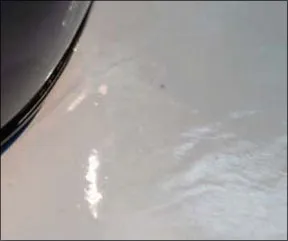
288
Crab Coat is not a water-based paint, but it is hydrophilic enough to allow water-only cleanup. It handles more like a blend between thick, creamy enamel and a water-based Latex. However, this paint is meant for exterior marine use. Time and our test panels will spell out how it weathers the environmental onslaught. It brushed on smoothly, but its Mystic Green color presented a somewhat streaky appearance.
Bottom Line: Though not as glossy as the current crop of urethanes, the Crab Coat produces a very appealing semi-gloss finish.
Conclusion
Topside and deck painting are labor-intensive undertakings that can rejuvenate an aging vessel as well as protect the substrate that lies beneath. Those enamored by the finish of the dark-blue Hinckley and Morris fleets have a tall order to meet.
Those willing to stay with white or a light color who are ready to invest equal amounts of time, patience, and skill, can parlay the cost of materials into a durable and attractive finish.
To say that the average roll-and-tip finish is just as good as a pro-sprayed finish would evoke too much of the Pinocchio factor. The results attainable by the average applicator can be quite good, but to hit the bull’s eye takes a steady hand, or the willingness to follow an autobody shop approach one of the paint manufacturers recommends.
One paint maker, Signature Finish, offers three sets of instructions, allowing DIYers to choose the level that suits them. Level 1 is straightforward: Apply three coats of their two-part paint (no primer), scuff sand between coats, and accept the last coat as the done deal. A Level 2 finish involves buffing with 3M Super Duty rubbing compound, and for those with more vigor and higher standards, there’s an exacting Level 3: Apply three or more coats, and once it’s dry (three to five days), wetsand it down to 1,200 or 2,000 grit followed up with the machine-buffing process. The workable acrylic LPU paint is highly buffable, and the result is a smooth, glossy surface, but care must be taken not to remove too much material.
Before committing to a big project, do a bit of testing of your own. A good test is to paint a pair of dinghy oars with good-quality enamel, then paint the inside of the dinghy with a one-part urethane, and finally flip it over, and go through a full prep-and-prime process that leads up to a roll-and-tip application of a two-part LPU paint. From this experience, you’ll have developed important painting skills and better understand the task that lays ahead.
All of the products we tested ranked at least acceptable in handlability, and many excelled. Only time will answer questions about durability and gloss retention.
Regardless of the paint you choose, be sure to review all of the manufacturer’s printed and online technical information, follow all safety procedures, and keep in mind that when it comes to painting, success is in the eye of the paint-brush holder.

































